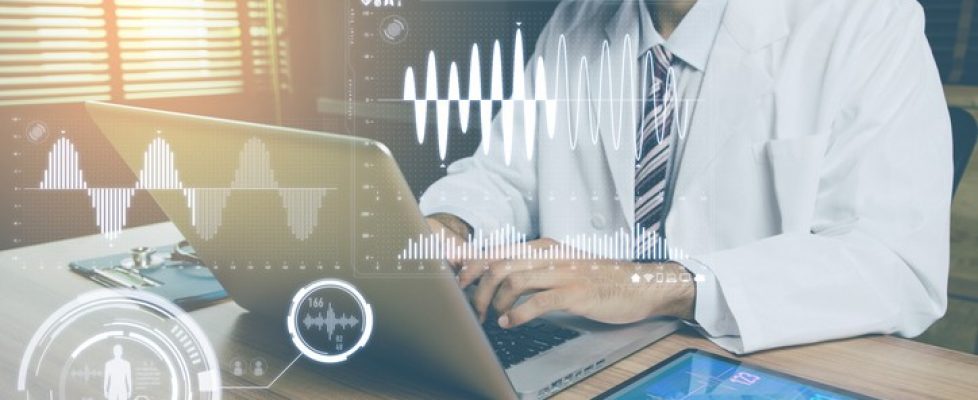ThinkLabs founder on healthcare innovations: ‘Convenience always wins’
Even after the pandemic, patients will be unwilling to return to the less-streamlined status quo, says Clive Smith.
By Kat Jercich October 09, 2020 01:29 PM
As the COVID-19 crisis began sweeping through the country this spring, hospitals sought a way for clinicians to treat infectious patients while maintaining distance from them if possible.
In that way, ThinkLabs founder Clive Smith told Healthcare IT News, smart devices that measured vital signs remotely, including from outside the exam room, became “essentially personal protective equipment.”
Particularly when hospitals were overwhelmed with patient numbers, said Smith, “doctors needed to be a safer distance from patients.”
Smith pointed to the high number of healthcare workers who have been infected, sometimes fatally, with coronavirus. Because of that, he said, “there was an incredible urgency” around getting useful devices into the hands of clinicians.
ThinkLabs, which produces a digital stethoscope, is among the companies whose monitoring devices saw a new use case during the COVID-19 pandemic. According to Smith, the company moved quickly to pivot around providers’ emerging needs, such as the ability to use the stethoscope, even while they were wearing a full protective hood or to listen to a patient’s vitals on loudspeakers from outside the room.
But even with COVID-19-fueled innovation, he said, medical devices are “relatively simple” compared to what people have in their homes.
“A patient’s smartphone is the most intelligent device in the hospital room,” Smith said.
As the market is flooded with connected devices and wearables, though, Smith said it’s important to be able to discern a signal in the noise.
“The issue’s going to be with what you do with this information,” he said. “What’s a doctor going to make of your FitBit information? How much information is there going to be among the data?”
“We’re moving toward intelligent patient-monitoring,” he predicted: turning this flood of data into something that’s informative and actionable. With many devices, he said, “you still need some level of interpretation.”
For example, a smart scale may be able to pack a patient’s weight loss, but may not have necessary context to interpret whether that’s a positive, negative or neutral sign in light of their medical history.
One way devices will get more clinically useful, he said, will be with the use of artificial intelligence and machine learning – even though, he cautioned, “there’s a lot of over-promising going on right now.” As other experts have said, AI isn’t magic, and expecting devices to deliver results without the help of professionals will likely mean disappointment.
The same holds true for at-home patient remote monitoring. Primarily, the ThinkLabs One stethoscope is used in a clinical setting. Unlike devices such as scales, oximeters or blood pressure monitors (which do produce fairly straightforward numbers, although context for that data remains important), Smith said, the stethoscope produces a complex signal that may be difficult to make sense of via telemedicine.
Still, he said, “there is a definite future for the stethoscope in the home. What will be needed is essentially a professional to interpret” the data.
Smith also forecasted a tension, particularly where virtual care is concerned, between patients’ and clinicians’ desires.
“I think that the healthcare system very much wants to get back to the status quo,” he said. “They would love to get back to life as normal, the normal approach to things.” But when it comes to innovation, “the patients are probably going to drive quite a lot of this.”
“What I always felt about telemedicine, is that essentially it was [like] buying books in 1996,” he explained. “In 1996, if you said to someone, ‘How do you feel about buying books online?’ they would say, ‘Buying it online is kind of a vacuous experience, I’d rather go to a bookstore.'”
“You fast forward, and eventually it’s too convenient” to avoid, he said. “I know that I can get it on my doorstep. Convenience eventually wins.”
Until recently, he said, there was a widespread cultural reluctance to adopt telehealth for everyday care. In much the same way, he predicted, after the pivot to telemedicine amidst COVID-19, patients will be unwilling to choose inconvenience: “It’s snowing outside. I’ve got to drive. I’ve got to park at the parking structure, I’ve got to walk in the cold, go in an elevator, sit in a waiting room, see the doctor. Are you crazy? Why would I do that?”
“There’s going to be a tug of war between physicians and [federal regulators] wanting to go backward” and those wanting to move forward, he said, “and I think in the end telemedicine will win.”

